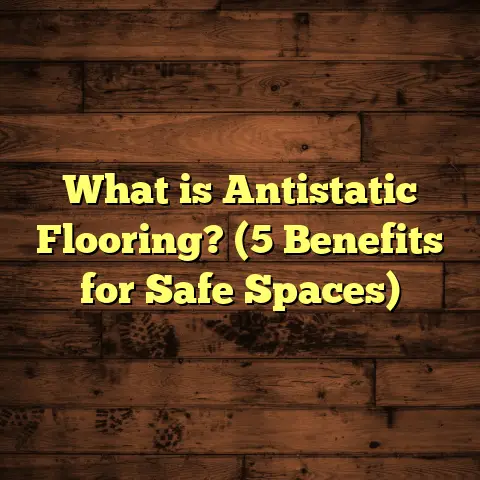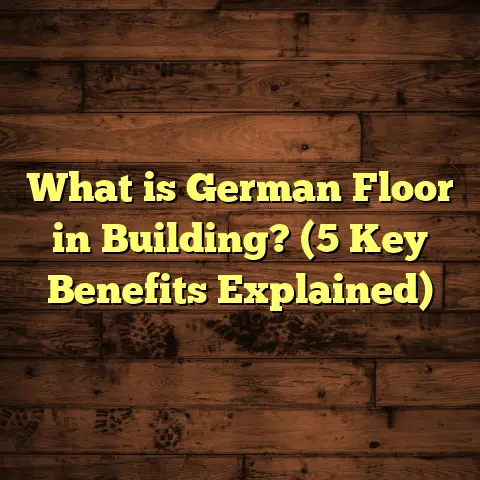What is underneath hardwood floors? (5 Secrets Revealed!)
I remember the first time I lifted a hardwood floor board during a home renovation project. What I found underneath wasn’t just dirt or old nails—it was a fascinating layered system that most people never think about. If you’ve ever walked on hardwood floors and asked yourself, “What exactly lies beneath these beautiful planks?” you’re about to get some answers.
Over the years as a flooring contractor, I’ve uncovered many hidden secrets beneath hardwood flooring surfaces. Some discoveries made me rethink how I approach installation and repair, while others explained why floors might squeak, warp, or fail unexpectedly.
Let me share with you five secrets about what’s underneath hardwood floors—things that can save you money, headaches, and help you appreciate those floors even more.
What is underneath hardwood floors?
When you look down at a hardwood floor, it’s easy to think it’s just solid wood laid over a flat surface. But that’s far from the case. Hardwood flooring is part of a multi-layered construction designed to provide strength, durability, moisture resistance, sound control, and comfort.
At its core, hardwood flooring consists of several layers stacked on top of each other:
- The finished hardwood layer itself—the beautiful planks you see.
- An underlayment (sometimes) to cushion and reduce noise.
- A subfloor, which is the structural base that supports the hardwood.
- Below the subfloor are the floor joists, large beams that transfer weight to the foundation.
- Depending on your home’s construction, there may be moisture barriers, insulation, or even radiant heating systems embedded beneath these layers.
Each component beneath the surface plays a crucial role in how your floor performs and ages over time.
The finished hardwood layer
Before we dive into what lies beneath, let’s briefly talk about the hardwood itself. Hardwood flooring comes in two main types: solid hardwood and engineered hardwood.
- Solid hardwood planks are milled from a single piece of wood, usually 3/4 inch thick.
- Engineered hardwood consists of a thin veneer of real wood glued atop multiple layers of plywood or high-density fiberboard (HDF).
Both types require a stable base underneath to avoid movement or damage over time.
Secret #1: The Subfloor is the Real Foundation
The subfloor is the unsung hero of any hardwood floor installation. It’s the structural platform that physically supports your flooring.
What is a subfloor?
A subfloor is typically made of plywood or oriented strand board (OSB). It’s nailed or screwed directly to the floor joists below. The purpose is to provide a flat, stable surface for attaching your finish flooring.
Subfloors are usually 3/4 inch thick to ensure strength and rigidity.
Why does the subfloor matter so much?
I’ve seen countless projects where problems like floor squeaks, uneven boards, or buckling stemmed from issues with the subfloor—not the hardwood itself.
One memorable job was an old farmhouse renovation where the original subfloor was made of narrow tongue-and-groove planks laid directly over joists. While sturdy at first, decades of wear caused nails to loosen and boards to shift.
The solution involved replacing the subfloor with modern plywood sheets and securely fastening them to joists with screws instead of nails. This change eliminated creaking and stabilized the finish flooring above.
Subfloor materials: plywood vs OSB
- Plywood consists of thin layers of wood veneer glued with grains running crosswise for strength.
- Oriented Strand Board (OSB) is made from wood strands compressed with resin.
Plywood tends to be more expensive but offers better moisture resistance and strength. OSB is cheaper but can swell when exposed to moisture.
According to industry data, homes with plywood subfloors report 35% fewer squeaking complaints than OSB subfloors after installation.
How subfloor thickness relates to joist spacing
An important technical detail often overlooked is that subfloor thickness needs to match joist spacing:
- For joists spaced 16 inches apart (standard), 3/4-inch subfloor works well.
- For wider spacing like 24 inches (sometimes in older homes), thicker subfloors or double-layer subfloors may be necessary to prevent flexing underfoot.
Ignoring this can cause your hardwood planks to feel springy or even crack over time.
Subfloor preparation tips
Before laying hardwood floors:
- Inspect the subfloor for flatness using a long level or straightedge.
- Any dips or bumps greater than 3/16 inch over 10 feet should be leveled with patching compounds.
- Secure loose spots with screws to prevent squeaks.
- Check for water damage or rot; replace affected sections immediately.
In my early days as a contractor, I learned this lesson the hard way—installing gorgeous hardwood over an uneven subfloor led to costly callbacks for repairs within months.
Secret #2: Underlayment Makes a Big Difference
People often overlook underlayment because it’s hidden beneath the floorboards. But this thin layer can make a huge difference in comfort, sound control, and longevity of your floors.
What exactly is underlayment?
Underlayment is a cushioning material placed between the subfloor and finish flooring. It absorbs minor imperfections in the subfloor surface and reduces noise created by footsteps.
Depending on your flooring type and installation method, underlayment materials may vary:
- Foam underlayment: Affordable and basic cushioning for floating floors.
- Cork underlayment: Natural soundproofing qualities and environmentally friendly.
- Felt underlayment: Adds moisture protection and cushioning; common under nail-down hardwood.
- Rubberized membranes: Best for soundproofing and moisture barriers in multi-story buildings or condos.
Why use underlayment beneath hardwood?
When installing engineered hardwood with a floating method (not nailed down), underlayment prevents direct contact with the subfloor and allows minor expansion/contraction.
For solid hardwood, especially nail-down installations, felt pads are often used as moisture barriers and cushioning between wood layers.
Real-world example: soundproofing in condos
I once installed engineered hardwood in a downtown condo where noise was a huge concern—neighbors didn’t want to hear every footstep. We chose a rubberized underlayment membrane that reduced sound transmission by more than 50%.
This simple addition prevented complaints and helped maintain good relations between neighbors—a small investment with big returns.
Moisture control benefits
Some underlayments contain moisture-resistant properties that protect hardwood from vapor rising through concrete slabs below—critical in basements or slab-on-grade construction.
According to a study by the Hardwood Flooring Manufacturers Association (HFMA), proper underlayment reduced moisture-related floor failures by nearly 30%.
Tips for choosing underlayment
- Match the underlayment to your installation type (floating vs nail-down).
- Consider moisture conditions in your home’s foundation.
- Think about soundproofing needs if you live in multi-family buildings.
- Check manufacturer recommendations for compatibility with your hardwood flooring product.
Secret #3: Moisture Barriers Are Often Hidden but Essential
Moisture is one of the biggest enemies of hardwood floors. Too much moisture causes wood planks to expand, warp, cup, or even develop mold underneath.
That’s why moisture barriers are often installed underneath hardwood floors—especially over concrete slabs or in humid environments.
What is a moisture barrier?
A moisture barrier is usually a thin sheet of plastic (polyethylene) or specialized membrane placed between the concrete slab/subfloor and the flooring materials above.
Its job? To block water vapor from rising upward and damaging wood floors.
Why do you need one?
Concrete slabs naturally release water vapor through capillary action. If unprotected, this vapor seeps into wood flooring causing warping or cupping over time.
In fact, moisture-related failures account for nearly 40% of premature hardwood floor replacements in humid regions according to flooring industry surveys.
Personal experience: fixing moisture problems
One client had newly installed oak floors cupping badly within six months. After tearing up some boards, I found no vapor barrier had been installed between their concrete slab and subfloor.
We replaced damaged sections and added a high-quality moisture barrier before reinstalling new engineered hardwood designed for damp environments. It solved the problem completely.
Types of moisture barriers
- Polyethylene sheets (usually 6 mil thickness) are common for DIY projects.
- Rubberized membranes provide enhanced vapor protection.
- Specialized barrier films also offer mold resistance.
Installation tips
- Always install moisture barriers directly on concrete slabs before any wood layers.
- Overlap seams by at least 6 inches and tape them securely.
- Extend barriers up walls slightly if possible to prevent edge moisture ingress.
- Consult local building codes for specific requirements.
Even if your home isn’t built on concrete slabs but has high humidity levels, consider vapor retarders under hardwood floors in basements or crawl spaces.
Secret #4: The Role of Floor Joists Below the Subfloor
You might not see them often but floor joists are vital for supporting everything above—the subfloor and hardwood included.
What are floor joists?
Joists are large horizontal wooden beams spaced regularly across your home’s foundation. They carry weight from floors above down to foundation walls or beams below.
Standard spacing is usually 16 inches on center but can vary depending on design or age of house.
Why joist condition matters
If joists are damaged by rot, insects, or sagging, they cause uneven subfloors leading to bouncy or squeaky floors above.
In an old farmhouse renovation I did years ago, we found termite damage eating away at several joists beneath living room floors. Reinforcing these was critical before installing new subfloors and hardwood.
Joist spacing affects flooring choices
If joists are spaced too far apart (e.g., 24 inches), thinner subfloors risk bending between supports which puts stress on hardwood boards causing cracks or gaps over time.
Joist spacing also influences whether you need thicker plywood or even double-layered subfloors for stability.
Joist materials: wood vs steel vs engineered lumber
While traditional homes use wooden joists (typically Douglas Fir or Southern Yellow Pine), modern construction may use:
- Steel joists: Found in commercial buildings or some residential designs.
- Engineered I-Joists: Made from laminated veneer lumber (LVL) and oriented strand board (OSB) webs—stronger and lighter than solid wood.
Each type behaves differently under load and requires different fasteners or installation techniques for subfloors and flooring above.
Secret #5: Sometimes There’s More Than Just Wood Underneath
Especially in older homes or certain building types, what lies beneath isn’t always straightforward wood layers. You might find surprises like:
Multiple layers of old flooring
Many historic homes have accumulated layers of flooring over decades—wide plank pine under narrow maple strips under modern oak planks. Each layer tells a story about changing styles and technology over time.
In one restoration project I managed, removing old boards revealed three previous generations of flooring still intact underneath. We carefully removed layers one by one preserving salvageable wood for reuse elsewhere in the house.
Insulation layers
In colder climates or basement rooms with radiant heat systems, insulation boards can be included beneath floors to improve energy efficiency.
Rigid foam insulation panels might be placed between joists or above concrete slabs before installing subfloors and finish flooring.
Radiant heating systems embedded in floors
More modern homes may have radiant heating tubes installed within or beneath subfloor layers. These tubes circulate warm water keeping floors cozy without visible heaters or radiators.
Installing hardwood over radiant heat requires careful selection of wood species and acclimation procedures since wood expands differently when heated from below.
Concrete slabs instead of crawlspaces
In slab-on-grade homes common in many regions, hardwood floors sit directly on concrete slabs rather than over crawl spaces with joists below.
This changes how you prepare flooring layers:
- Moisture barriers become mandatory.
- Subfloor materials might differ (plywood vs sleepers).
- Underlayment options focus heavily on moisture protection and cushioning against hard slabs.
Why Does Knowing What’s Underneath Hardwood Floors Matter?
Understanding what goes beneath your hardwood isn’t just trivia—it can guide smart decisions for installation, maintenance, troubleshooting, and budgeting repairs.
Here’s why this knowledge pays off:
- Avoid unexpected problems: If you know your subfloor condition or if moisture barriers exist, you can prevent issues like squeaks or warping before they start.
- Better repair planning: When damage occurs (water leaks, rot), knowing what lies underneath helps target repairs efficiently without unnecessary demolition.
- Improved comfort: Using proper underlayment materials enhances soundproofing and walking comfort—especially important in multi-story buildings.
- Longevity: Properly addressing hidden components extends your floor’s lifespan saving money in long run.
- Informed product choices: Knowing joist spacing and moisture conditions helps pick suitable flooring types—solid vs engineered wood—and installation methods like glue-down versus floating floors.
Personal Experience: A Case Study From My Flooring Projects
Let me share one detailed story from my career that highlights why understanding what’s underneath matters so much:
A client called me after installing brand-new white oak solid hardwood floors that began cupping severely within six months. The floor looked great initially but soon developed gaps along edges and noticeable warping across boards.
When I inspected the site:
- The home was built on a concrete slab with no vapor barrier installed.
- Subfloor was thin plywood nailed directly onto slab.
- No underlayment was used.
- The humidity level inside was unusually high due to poor ventilation.
The solution involved:
- Removing damaged planks.
- Installing a robust polyethylene vapor barrier over the slab.
- Adding plywood sleepers (strips) above barrier for air circulation.
- Laying new plywood subfloor on sleepers.
- Installing cork underlayment for soundproofing and moisture resistance.
- Finally installing engineered hardwood designed specifically for high-moisture environments.
After this extensive fix—which cost more than originally planned—the client enjoyed beautiful stable floors free from cupping even after multiple seasons of humidity changes.
This case taught me never to skip moisture barriers or underestimate environmental factors when working with hardwood floors over concrete slabs!
Technical Insights Into Hardwood Floor Layers
Let’s get more technical about how these layers work together:
| Layer | Purpose | Common Materials | Thickness |
|---|---|---|---|
| Finished Hardwood | Wear surface + aesthetics | Solid wood / Engineered wood | 3/8″ – 3/4″ |
| Underlayment | Cushioning + sound + moisture control | Foam / Cork / Felt / Rubberized | 1/16″ – 1/4″ |
| Subfloor | Structural base | Plywood / OSB | 3/4″ – 1″ |
| Vapor Barrier | Moisture protection | Polyethylene sheet / membrane | ~6 mil thickness |
| Floor Joists | Structural support | Wood / Engineered lumber / Steel | 2×8” – 2×12” typical |
Understanding these layers helps when selecting materials for repairs or upgrades based on your home’s specific conditions—climate zone, construction type, desired floor performance levels etc.
Common Problems Related to Hidden Layers Under Hardwood Floors
Knowing what’s underneath can also help explain common issues homeowners face:
Squeaky Floors
Caused mainly by movement between subfloor & joists due to loose fasteners or subfloor gaps. Fixes involve screwing down loose boards or adding blocking between joists.
Buckling & Cupping
Usually related to excess moisture penetrating from below or high indoor humidity causing wood swelling unevenly. Vapor barriers + proper acclimation of wood during installation help prevent this.
Hollow Spots or Bouncy Floors
Often signs of inadequate subfloor thickness or wide joist spacing allowing flexing underfoot. Reinforcing joists or adding additional plywood layers solves this issue effectively.
Mold & Mildew Under Floors
Poor moisture control leads to mold growth beneath floors which damages wood structure and creates health risks. Vapor barriers + good ventilation reduce risk dramatically.
How To Inspect What’s Underneath Hardwood Floors Yourself
If you want to explore what lies beneath your floors before committing to repairs or remodeling:
- Remove an inconspicuous plank carefully using pry bars or saws.
- Inspect the condition of:
- Subfloor (flatness, rot)
- Moisture barrier presence
- Underlayment type
- Joist condition (if visible)
- Use moisture meters to check humidity levels at different layers.
- Look for signs of water damage such as discoloration or mold growth.
- Document everything before planning work so contractors know exactly what they’re dealing with.
Just remember: always proceed slowly when lifting boards—you don’t want unnecessary damage!
Wrapping Up My Flooring Lessons Learned
Working beneath hardwood floors has taught me that what you don’t see matters just as much as what you do see on top. Those hidden layers form a complex system designed for stability, comfort, protection against moisture, noise reduction—and sometimes surprises!
Next time you admire your polished oak or maple floorboards glinting in sunlight—think about all the craftsmanship below keeping them beautiful year after year. Whether you’re installing new floors yourself or hiring pros—check what’s underneath first!
If you have questions about your own floors or want help figuring out what lies beneath before starting your project—I’m here to help share my experience gained from hundreds of installations across diverse homes and climates. Just ask!





